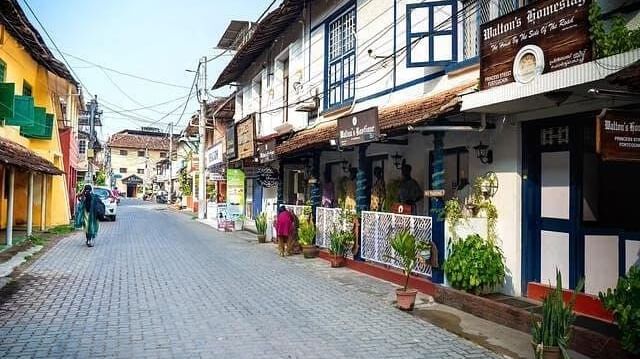- Experiencing the Kochi
- Neelakurinji in Munnar
- Munnar – Famous Tourist’s Spot
- Top Tourist Places to Visit in Kollam
- Vasco da Gama Square
- Welcome to the Queen of Arabian Sea, Kochi
- Spice Route - Fort Kochi
- Ashtamudi Lake, Kollam
- Places to Visit in Kollam
- Munnar- Kashmir of South India
- Munnar- Tea Plantations
- Best Honeymoon Destinations in Kerala
- A Luxurious Kerala New Year: From Backwaters to Hilltops at Fragrant Nature Resorts
- December in Kerala: A Journey of Sunshine, Festivity, and the Fragrant Nature Experience
- Where Wellness Meets Luxury: Your Perfect Winter Retreat at Fragrant Nature.
- Places to Visit in Munnar in 3 Days
- Places to Visit in Kochi in Two Days
- From Backwaters to Hilltops: What Excites More in Kerala?
Spice Route - Fort Kochi
The Spice Route in Fort Kochi is a fascinating part of Kerala’s heritage that connects Kochi to the ancient maritime trade networks of the world. Here’s an overview.
For over 2,000 years, Kochi and nearby Muziris (modern-day Kodungallur) were vital ports on the legendary Spice Route. Traders from Rome, Greece, Arabia, China, and later Portugal, the Netherlands, and Britain sailed here seeking spices like black pepper, cardamom, cinnamon, ginger, and cloves. Pepper from Kerala was famously called “Black Gold” because of its high value in Europe.
Arab traders were among the earliest to arrive, followed by the Chinese, Jews, and later the Portuguese, Dutch, and British. Each left behind not just trade records, but fragments of their culture woven into the fabric of Fort Kochi.
Walk through Jew Town in Mattancherry, and you’ll sense the past in the air. Lined with antique shops and spice warehouses, this street still carries the fragrance of cardamom, pepper, and clove. Many of these old go downs have been transformed into quirky cafés, boutiques, and art galleries—yet the spice spirit remains alive.
Paradise Synagogue, built in 1568, this is the oldest functioning synagogue in the Commonwealth. It was once the spiritual and cultural heart of the Jewish traders who played a vital role in the spice business. Its hand-painted tiles and chandeliers are living reminders of Fort Kochi’s global ties.


Mattancherry Palace (Dutch Palace), gifted by the Portuguese and later renovated by the Dutch, this palace is a window into Kerala’s royal history. Beyond its stunning murals, it narrates how colonial powers jockeyed for control of the spice trade.
Kochi is now part of UNESCO’s Spice Route Initiative, which aims to reconnect the 31 countries that were once linked by spice trade. This project not only celebrates history but also revives cultural exchanges, reminding us that spices did more than flavour food—they connected people, ideas, and traditions.
Take a heritage walk through Fort Kochi’s narrow lanes. Browse spice shops in Mattancherry, where you can still buy the finest pepper and cardamom. Sip a masala chai in a restored spice warehouse turned café. Visit nearby Muziris, once the greatest spice port, now revived through the Muziris Heritage Project and stay at Fragrant Nature Kochi- a five-star boutique hotel located in the historic heart of Fort Kochi, blending colonial heritage with modern luxury. The hotel retains a colonial façade with high ceilings, wooden beams, classic architecture and interiors combine heritage aesthetics with chic design, featuring artwork, elegant lighting, and warm tones. Many rooms overlook the Cochin Harbour, offering scenic sunrise and sunset views. Indulge in traditional Ayurvedic therapies and rejuvenation treatments. Enhance your stay with elegant rooms with cosy interiors, rooms offering stunning waterfront views and all-day dining restaurant serving Kerala delicacies, pan-Indian, and global cuisine.
The Spice Route may no longer see dhows and galleons anchored off its shores, but in Fort Kochi, its essence lingers. Every spice-scented breeze, every cobbled street, every colonial building is a reminder that this was once the hub of a trade that shaped the world. So, when you walk through Fort Kochi, pause for a moment. Inhale deeply. The air still carries whispers of the Spice Route.